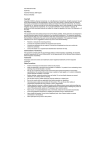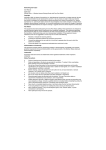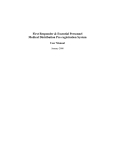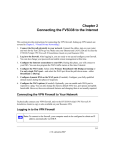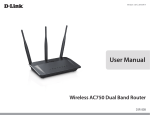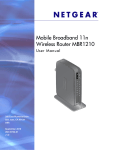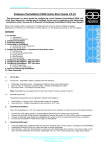Download Networking the Future User Manual
Transcript
Networking the Future PalmRouter PR-100 Internet Sharing Router with Four-Port Switch User Manual Copyright Copyright © 2001 by Xsense Connectivity, Inc. All rights reserved. No part of this documentation may be reproduced in any form or by any means or used to make any directive work (such as translation or transformation) without permission from Xsense Connectivity, Inc. Xsense Connectivity, Inc. reserves the right to revise this documentation and to make changes in content without obligation among Xsense Connectivity, Inc. to provide notification of such revision or change. All products and their associated features are subject to change or upgrade at the time of the shipment or of the sales. FCC Notice This equipment has been tested and found to be FCC Rules certified. These restrictions are designed to provide protection against harmful interference from residential installations. This equipment generates radio frequencies that may cause interference with radio communications if not used in accordance with the instructions. Interference may even occur during proper installation. If this equipment causes interference, the user is suggested to correct it by one or more of the following: Increase the separation between the equipment and receiver. Connect the equipment into an outlet on a circuit that is separate from the one to which the receiver is connected. Consult the dealer or an experienced radio/television technician for help. CE Declaration of Conformity The equipment complies with the requirements relating to electromagnetic compatibility, the essential protection requirement of Council Directive/EEC on the approximation of the Member States relating to Electromagnetic compatibility. Trademarks All products and brand names are trademarks and/or registered trademarks of their respective companies. Safety Precautions Follow all warnings and instructions marked on the product. Slots and openings on the device are provided for ventilation. To protect it from overheating, these openings must not be blocked or covered. Do not use or store this product in the environment that exceeds temperature and humidity specifications. Do not place this product near a radiator or heat register, or in a built-in installation unless adequate ventilation is provided. Before cleaning, unplug this product from wall outlet. Do not use liquid cleansers or aerosol cleansers. Use a damp cloth for cleaning. Do not place cords or cables where they may be walked on or tripped over. Be sure to comply with any applicable local safety standards or regulations. General-purpose cables are provided with this product. The use of any other cables or requirements mandated by local authority is user’s responsibility. Cables attached to devices in different locations with different power sources and grounding may cause hazardous voltage. Consult a qualified electronic consultant before installing the product to check if this phenomenon exists and, if necessary, take corrective action. Never touch un-insulated telephone wires or terminals unless the line has been disconnected. Avoid using telephone equipment or installing the product during an electrical storm. Never install this product, or any kind of telephone jacks, lines, network cables, or power connections in wet locations. Never spill liquid of any kind on this product. i TABLE OF CONTENTS 1.0 INTRODUCTION.........................................................................................1 1.1 Features ..................................................................................................1 1.1.1 Sharing Internet Access.................................................................1 1.1.2 Support Broadband Connection ....................................................1 1.1.3 Built-in DHCP Server .....................................................................1 1.1.4 Built-in 4-Port Switched Ethernet Hub ...........................................1 1.1.6 Easy Configuration ........................................................................2 1.1.7 Security .........................................................................................2 2.0 BEFORE YOU START ................................................................................3 2.1 Package Overview...................................................................................3 2.2 System and Other Requirements.............................................................3 3.0 GETTING TO KNOW PALMROUTER ........................................................4 3.1 Front Panel ..............................................................................................4 3.2 Rear Panel...............................................................................................5 4.0 INSTALLING PALMROUTER .....................................................................6 4.1 Connecting the PalmRouter to Your DSL/Cable Modem .........................6 4.2 Connecting Computers to the PalmRouter ..............................................7 5.0 CONFIGURING CLIENT COMPUTERS .....................................................9 5.1 Windows 95/98/Me TCP/IP Configuration................................................9 5.2 Assigning TCP/IP Values Manually ........................................................ 11 6.0 BASIC CONFIGURATION ........................................................................13 6.1 ISP Connection Types ...........................................................................13 6.2 Access the Web-Based Config Pages ...................................................14 6.3 One Page Setup ....................................................................................15 6.3.1 Dynamic Configuration ................................................................16 6.3.2 Static Configuration .....................................................................17 6.3.3 PPPoE.........................................................................................17 6.4 Status Monitor........................................................................................19 6.5 DHCP Settings.......................................................................................20 6.6 Device Administration ............................................................................21 6.7 DMZ (Demilitarized Zone) Host .............................................................22 7.0 FIRMWARE UPGRADE............................................................................23 8.0 TROUBLESHOOTING..............................................................................24 8.1 Common Problems and Solutions .........................................................24 8.2 Frequently Asked Questions..................................................................26 APPENDIX......................................................................................................28 Specifications...............................................................................................28 GLOSSARY ....................................................................................................29 ii 1.0 INTRODUCTION Congratulations on your purchase of the Xsense PalmRouter, the Economical Internet Sharing Router with Four-Port Switch. Welcome to the Xsense Product Family. The PalmRouter provides home and small office PC users with an economical yet feature-rich way to share Internet access via their DSL/Cable broadband connection. PalmRouter is the entry-level member of the Xsense Internet Sharing Router family. It comes with the most essential functions and it is easier to set up and maintain. You don't have to bother tinkering with advanced parameters for complicated environments that you may not have. Most importantly, these essential functions are packed into a very attractive palm-size unit that anyone can afford. 1.1 Features The PalmRouter is an embodiment of many essential features. The major features are: 1.1.1 Sharing Internet Access The PalmRouter functions as an easy-to-use communication device, which allows you to connect a local area network (LAN) to the Internet affordably. With the PalmRouter you can get as many as 253 PC users online simultaneously through one DSL line or Cable, with one ISP account. The PalmRouter installs quickly and easily, and best of all, it’s a breeze to use. PalmRouter supports dynamic, static and PPPoE addressing and is compatible with virtually all ISPs. 1.1.2 Support Broadband Connection The PalmRouter supports both DSL modems and Cable modems broadband Internet connections. It has one WAN (Wide Area Network) port to connect itself to a DSL modem or a Cable modem. This provides more than enough bandwidth to accommodate the needs of even large groups of Internet users. 1.1.3 Built-in DHCP Server The PalmRouter’s built-in DHCP Server dramatically reduces the amount of efforts needed to configure and maintain connected PCs by automatically assigning IP addresses to each one of them. 1.1.4 Built-in 4-Port Switched Ethernet Hub In addition to providing Internet sharing capability, the PalmRouter also functions as an N-way switched Ethernet hub, which offers four 10/100Mbps switched RJ-45 ports that allow you to connect a series of computers to form a small LAN. One uplink port is provided for cascading to more hubs and switches. 1 1.1.6 Easy Configuration The PalmRouter can be configured through a popular web browser, and it features web-based management for a simple, intuitive set up. It allows for remote administration for convenience and tech support. 1.1.7 Security The PalmRouter provides firewall-like security through NAT (Network Address Translation) to prevent unauthorized Internet users from accessing internal files. NAT translates private local IP addresses into a global IP address on the Internet, allowing a group of Internet users to share a single ISP account. Also, PalmRouter runs in Stealth Mode when WAN Port Scanning/WAN Ping Response Block is enabled. 2 2.0 BEFORE YOU START 2.1 Package Overview Prior to setting up your PalmRouter, make sure your PalmRouter package includes the following items: One PalmRouter unit (Model Number PR-100) One Power Adapter One User Manual and Registration Card One Category-5 UTP Ethernet cable with RJ-45 connectors 2.2 System and Other Requirements ISP account with DSL/Cable Modem Broadband Internet connection Desktop computer(s) with 10Mbps or 10/100Mbps Ethernet connection to support TCP/IP protocol Windows 95/98/Me/NT4/2000 or that of later versions Netscape Navigator 4.7 or Microsoft Internet Explorer 5.0, or later versions of the web browsers 3 3.0 GETTING TO KNOW PALMROUTER This chapter first gives a description of the LED indicators and ports of the PalmRouter unit. Then it outlines the steps in installing and configuring the unit to work with your network environment. 3.1 Front Panel The Front Panel LED lights provide a status display indicating transmission and other activities. Figure 1 Power On Indicates that there is power to the unit. Self Test On Indicates a bootup or reset process. On Indicates a 100Mbps connection is detected on the corresponding port. LAN Ports 100M Off Indicates the port is running at 10Mbps. On Indicates a proper connection with a computer. Flashing Indicates activity on the port. On Indicates full duplex mode. Off Indicates half duplex mode. Link On Indicates proper connection with the Internet/Ethernet. ACT Flashing Indicates that data packets are flowing through the port. Off Indicates idle. Link/ACT FD WAN Port Table 1 4 3.2 Rear Panel Figure 2 WAN Ethernet Port One Wide Area Network port for connecting the PalmRouter to the Internet via a DSL or Cable modem. Uplink Buton Used to determine the configuration of the PalmRouter’s LAN port No. 4. Choose either UP-position (straight-through) for connecting LAN computers to the PalmRouter or DOWN-position (uplink) for cascading a series of hubs or switches to the PalmRouter. LAN Ethernet Ports Four 10/100Mbps Ethernet network (RJ-45) ports used for linking computers and printers to form a Local Area Network with the PalmRouter. 12VDC/1.2A Power Adapter Receptacle Plug the power adapter cable into this port to supply power to the PalmRouter unit. 5 4.0 INSTALLING PALMROUTER Prior to connecting the PalmRouter to LAN, please be certain that your DSL or Cable service is active and operating correctly. If you are experiencing difficulties with the DSL or Cable service, please contact the service provider before continuing the installation process. 4.1 Connecting the PalmRouter to Your DSL/Cable Modem After verifying that your DSL or Cable service is functioning properly, connect the DSL modem or Cable modem to the PalmRouter by following the instructions below: 1. Disconnect the Ethernet cable from the computer that is currently connected to the DSL or Cable modem if you have not done so. 2. Plug the power adapter of the PalmRouter into an AC power outlet. 3. Plug the RJ-45 connector from this cable into the WAN (Wide Area Network) port on the rear panel of the PalmRouter. Verify WAN LED is green ensuring proper connection (See Figure 1). 4. Leave the other end of this Ethernet cable connected to the DSL modem or Cable modem. Figure 3 6 4.2 Connecting Computers to the PalmRouter When you finish connecting the PalmRouter to your DSL or Cable modem, you may now connect PC computers in your local area network to the PalmRouter. Two methods can be implemented for the connection: (1) plugging computers directly into the PalmRouter, and (2) connecting the PalmRouter to your LAN hub. We suggest performing the initial installation process with just one computer connected to the PalmRouter and add the hub later. Connect Computers Directly to the PalmRouter: NOTE: You will need an Ethernet cable for each additional computer connecting to the PalmRouter. 1. Plug one RJ-45 connector (of a standard twisted-pair Ethernet cable) to the Ethernet port on your computer. 2. Plug the other end of this cable into one of the PalmRouter’s four LAN ports. 3. Repeat steps 1 and 2 for each computer you wish to provide Internet access to until all four PalmRouter LAN ports are filled. NOTE: To connect more than four computers to the PalmRouter, simply plug additional computers into a network hub and plug this hub into the PalmRouter’s uplink port. Read below for further instructions. (See Figure 5) Figure 4 To connect an existing LAN to the PalmRouter: As an alternative to connecting computers directly into the PalmRouter’s LAN ports, you can also connect a pre-existing network to the PalmRouter by uplinking your network’s central LAN hub to the PalmRouter’s uplink port. To connect a LAN hub to the PalmRouter’s uplink port: 1. Push the Uplink Button down (located on the PalmRouter’s rear panel just left of the No. 4 LAN port). 2. Plug one RJ-45 connector (of a standard twisted-pair Ethernet cable) to the PalmRouter’s No. 4 LAN port. 3. Plug the other end of this Ethernet cable into an available standard port on the network hub. Do not run the connection from uplink port on the router to uplink port on hub. NOTE: Multiple network hubs can be connected to the PalmRouter’s LAN ports No.1-3 if these hubs are equipped with uplink ports. By cascading a series of hubs, you can connect up to 253 users to the PalmRouter. 7 Figure 5 8 5.0 CONFIGURING CLIENT COMPUTERS Congratulations on installing the PalmRouter’s hardware! Next we will show you how to enable communication between the PalmRouter and client computers. Part of the process of enabling communication involves setting the IP addresses for the computer. These computers must have their IP addresses configured such that they share the same subnet numbering scheme, as does the PalmRouter’s default IP address. We will explain this in more detail later in the chapter. Configuring the IP addresses is a simple task that can be performed through your computer’s TCP/IP control panel. We have provided instructions for the configuration process for PC users. Find the appropriate set of instructions in the following pages. 5.1 Windows 95/98/Me TCP/IP Configuration 1. Double-click the Control Panel icon in My Computer folder or locate it in the Start Menu. The sub-folder Control Panel is located under Settings. 2. In the Control Panel, double-click the Network icon. The network interface card (installed on your computer) appears along with the network protocol on the Configuration list. Figure 6 3. Double-click TCP/IP protocol on the list. If TCP/IP does not appear on the list, you must install the TCP/IP protocol first as illustrated in step 4. Clients with TCP/IP already installed may skip to step 5. 4. To install the TCP/IP protocol: a. Keep your copy of Windows 95/98/Me CD-ROM on hand. (You will need it for this installation.) b. Click the Add button from the Configuration list of the Network window. A new window appears. c. Double-click Protocol. Then, in the Select Network Protocol window, 9 choose Microsoft on the Manufacturers list, and select TCP/IP on the right side of the list. Figure 7 Follow the instructions on the screen to complete the installation process. It should prompt for a restart and then follow on with step 5, as you will now find a TCP/IP Protocol in your Network control panel. 5. After double-clicking the installed TCP/IP protocol, the TCP/IP Properties window appears. To automatically assign computer’s TCP/IP, the PalmRouter’s DHCP server must perform the following functions: a. Click the IP Address tab from the TCP/IP Properties window. (See Figure 8) b. Select the item Obtain IP address automatically to allow the built-in DHCP server of the PalmRouter to assign an IP address and other TCP/IP configuration information to the client automatically. Do this for every client which needs Internet access through the PalmRouter. Figure 8 10 6. After specifying the settings of TCP/IP click OK and restart Windows to allow the settings to take effect. 7. Repeat steps from 1 to 6 for each client PC on you Local Area Network. When all of your client PCs are configured, please go to Chapter 6 to set up your PalmRouter. Note: If you already have a DHCP server on your network that assigns local IP addresses to each computer, then you should turn off the built-in DHCP server in the PalmRouter. Refer to Section 6.5 to learn about how to turn off the DHCP server in the PalmRouter. 5.2 Assigning TCP/IP Values Manually If you already have a DHCP server on the network, or if you prefer not to use the PalmRouter’s DHCP server to assign TCP/IP values automatically, you can input these values manually. To manage a computer’s address manually, perform the following steps: Click the IP Address tab from the TCP/IP properties window. 1. Select the item Specify an IP address to manually input unique IP address and Subnet Mask. Do this for every client which needs Internet access through the PalmRouter. (See Figure 9) 2. In the IP Address field enter “192.168.1.x” where x is any variable of your choice ranging from 2 to 253. Enter “255.255.255.0” in the Subnet Mask field. NOTE: No two computers on the LAN are allowed to adopt the same IP address or an IP address conflict will occur. Figure 9 11 3. Click the Gateway tab and enter the PalmRouter’s Private IP Address “192.168.1.1” in the Gateway IP address field and click Add. The Gateway IP address value must be the same as the PalmRouter's IP address to keep the proper IP numbering scheme. Figure 10 4. Click the DNS Configuration tab, choose Enable DNS and input a unique Host Name that simply is the computer’s name on the network. Enter the DNS IP addresses provided by your ISP in the proper order into the DNS Server Search Order field and click Add. Figure 11 5. 12 Click OK to close out of both windows and you will be prompted to restart the computer to activate these changes. 6.0 BASIC CONFIGURATION Now that you have completed the configuration of TCP/IP addresses on the client computer(s), you may begin configuring the PalmRouter’s Internet settings. This can be done through a standard Web browser (such as Netscape Navigator 4.7 or Microsoft Internet Explorer 5.0 and higher). 6.1 ISP Connection Types Before you begin with setting the PalmRouter configuration, you must verify that you have one of the following ISP connections: Static: If your connection is static, your ISP has provided you with the necessary values for IP Address, Subnet Mask, Default Gateway/Router Address and Domain Name Server addresses. These would have been configured in the TCP/IP control panel for your computer to connect to the Internet directly through the modem. Dynamic: The PalmRouter, by default, is configured for a dynamic connection and can dynamically obtain a WAN IP Address from the ISP so there is no further configuration needed. Although, we suggest inputting the DNS numbers into both the TCP/IP control panel of the computer and the DNS fields on the One Page Setup screen. If you do not have these DNS numbers, you can obtain them from your ISP. PPPoE: Dynamic PPPoE: The majority of PPPoE connections are dynamic and only require the configuration of the PPPoE section. However, we do suggest inputting the DNS numbers into both the TCP/IP control panel of the computer and the DNS fields on the One Page Setup screen. Such ISPs using PPPoE are PacBell, BellAtlantic, BellSouth, Southwestern Bell, Bell Sympatico, Earthlink/Mindspring among others. Static PPPoE: If your service is Static PPPoE, you will need to input the static values into the One Page Setup and then continue on to configure the PPPoE section. However, this type of account is uncommon. NOTE: Some cable modem ISPs (i.e. Media One, Time Warner, Roadrunner) may require a MAC Address (hardware address of a network device) to be registered. In this case, you will need to provide the Public IP MAC Address to your ISP found on the One Page Setup screen. See the FAQs on our website for further detail. To access the PalmRouter’s One Page Setup screen, follow the instructions below. 13 6.2 Access the Web-Based Config Pages 1. Launch your web browser. 2. In the URL field, type the PalmRouter's default IP address (192.168.1.1) and hit Enter key on the keyboard. This is the area where you would normally enter a Web site address such as “www.xsense.com”. There must be no Proxy settings configured in your browser preferences. 3. The Username and Password window will then appear. Leave the Username field blank and type “admin” as the default password for the PalmRouter. If it does not appear, check your cable connections and TCP/IP settings. Also, see the Troubleshooting Section. Note: Password is case sensitive so verify that Caps Lock is off. 4. Click OK. Figure 12 Note: It is recommended to change the default “admin” password of your PalmRouter for security purposes. This can be done n the “Device Admin.” page of the web-based configuration of the PalmRouter. For more information on the “Device Admin.” page please refer to Section 6.6 on this manual. 14 6.3 One Page Setup The One Page Setup window now appears. Note that this page is divided into two basic sections: LAN IP Address and WAN IP Address. Figure 13 Host Name: This is an optional section. Some ISPs, such as The @Home Network and Cox Cable, require a host name for authentication purposes in order to be recognized by their systems. Your ISP should provide this if it is needed for their systems. See our FAQ about this issue on our website at www.xsense.com. 15 Domain Name: A domain is a set of network resources (printers, databases, servers, etc.) for a group of users. Once the user has logged in and been authenticated by the domain, they have access to the resources. If your ISP doesn’t require a Domain Name, and most do not, then leave this field blank. LAN IP Address: Here, the PalmRouter’s internal IP Address can be changed, such as in the case of the PalmRouter connecting to a much larger corporate LAN network. However, we recommend that you do not alter the default IP address “192.168.1.1” unless some modifications are necessary to be made for your network environment. WAN IP Address: By default, this section is configured for a dynamic connection. However, this section can be used to manually enter IP address information provided by your ISP. You will not need to make changes to the default values in this section if the ISP automatically assigns IP addresses. However, if it provides you with a static IP address, you will need to enter this information by following the instructions below. 6.3.1 Dynamic Configuration The PalmRouter is setup for a dynamic connection by default. It is suggested to obtain the proper DNS addresses from your ISP and enter them both in the One Page Setup screen of the PalmRouter and in the TCP/IP control panel of the computer. PalmRouter DNS Configuration 1. Connect to the One Page Setup screen. 2. Enter your DNS addresses into the DNS 1, 2 and 3 fields. Leave field 3 blank if you only have two DNS numbers. 3. Click Apply to save changes. PC DNS Configuration 1. Open your Network control Panel. 2. Choose the TCP/IP option for your NIC card and click Properties. 3. Click the DNS tab. 4. Choose Enable DNS and enter a unique Host Name. 5. Enter the DNS addresses in the DNS Server Search Order and click Add. 6. Click OK, then OK and restart the computer when prompted. After the Domain Name Server addresses have been inputted into both the TCP/IP control panel and the DNS fields on the One Page Setup, you can open your browser to establish a connection to the Internet. 16 6.3.2 Static Configuration To make changes to the WAN IP Address fields, connect to the One Page Setup and complete the following: Figure 14 1. Select Specify an IP Address. 2. Enter the static IP address provided by your ISP in the field located immediately to the right of Specify an IP Address. 3. Enter the Public Subnet Mask provided by your ISP. 4. In the Default Gateway IP Address field, enter the information provided by your ISP. Note that it may refer to “Gateway / Router IP Address.” Also, note that this number is not the same as the IP Address value that you have entered in step 2. 5. Enter the DNS information provided by your ISP in the Domain Name Server fields. It should provide at least two unique DNS numbers. 6. Click Apply to save your changes. 7. Use your browser to establish an Internet connection to a website. Note: If you experience any troubles, please refer to our Troubleshooting and FAQ section. 6.3.3 PPPoE Dynamic PPPoE Configuration The PPPoE section on the One Page Setup takes the place of your ISP’s proprietary software such as WinPoET and EnterNet 300. This software is limited to only a direct connection with the modem and will not be used with our PalmRouter. Major PPPoE ISPs include PacBell, Bell Atlantic, Earthlink/Mindsrping, Southwestern Bell, Bell South and Bell Sympatico (Canada). The PalmRouter can dynamically obtain a WAN IP Address from the ISP so there is no further configuration needed than the PPPoE section. Although, we suggest inputting the DNS numbers into both the TCP/IP control panel of the computer and the DNS fields on the One Page Setup screen. If you do not have these DNS numbers, you can obtain them from your ISP. 17 Proceed with the following steps to configure the PalmRouter for a PPPoE connection. Figure 15 PPPoE Configuration Steps: 1. Click PPPoE to enable this protocol for your connection. 2. Enter the username assigned by your ISP. (i.e. ELN/[email protected]) 3. Enter the password assigned by your ISP. Enter the service name only if required. Most ISPs do not use a service name. 4. Enable Connect-on-Demand. 5. Hit Apply to save these changes. 6. Use your browser to establish an Internet connection to a website. Service Name: This field is optional and is not needed for all ISPs. Input the Server Name in this field only if your ISP requires it. Connect-on-Demand: This feature allows the router to initiate a connection with your ISP when an Internet request is made to the PalmRouter. If you enable the PalmRouter’s Connect-on-Demand feature, a connection to the Internet will automatically be initiated when you open your web browser. We recommend having this feature enabled if you do not wish to enter the web-based configuration to access the Internet manually. Disconnect when network idle: This field allows you to enter the amount of idle time (in minutes) required prior to being disconnected from the ISP. For example, if you set the idle to “10”, then the PalmRouter will disconnect your PPPoE connection after 10 minutes of idle time. Enter “0” to enable keep alive mechanism. Disable Connect-on-Demand will disable this feature at the same time. PPPoE Management: Connect – Use to manually establish a PPPoE connection. Disconnect – Use to manually disconnect the PPPoE session. More Status – Provides information on PPPoE Status. NOTE: If connection problems occur, please verify your Internet connection while connected directly to the modem. 18 6.4 Status Monitor The status monitor provides information on the working status of the PalmRouter. It contains the connection information for the WAN and LAN side of the router. The term WAN (Wide Area Network) refers to the connection going to the ISP. Figure 16 If you select the “Get an IP address automatically” option in the One Page Setup page, then you will see two addition buttons on the Status Monitor page: WAN IP Release: This will release the ISP connection information preparing it to be renewed. Although several values will be cleared including IP Address, Subnet Mask, Default Gateway and DCHP Server values, some will remain the same because they are static addresses from the ISP. WAN IP Renew: This will update or renew the ISP connection information. For ISPs that have short DHCP lease times, this can help maintain the connection. On the bottom of the page are two other buttons that allows you to view other statistics related to the connection. DHCP Clients Table: This allows you to view DHCP clients on the LAN side of the router. Statistics: This allows you to view the general traffic on the route, and to display the IP address as well as the number of packets translated for each client. Note: The screens shown above for the Status Monitor do not show actual connection. During an actual connection, IP address information will be listed. 19 6.5 DHCP Settings The DHCP Server will automatically assign IP address information to computers configured to use the DHCP Server. There is no need to disable the DHCP Server, even if you have given your machines static IPs, unless you have another DHCP Server on the network. The DHCP Server begins assigning IPs at 192.168.1.100 and increases by one for each additional request for an IP. Remember to hit Apply after making any changes to this page. Figure 17 20 6.6 Device Administration This page displays information on the firmware version of the PalmRouter. You can also change the password, reset the device and disable or enable external administrative access to the web-based configuration of the PalmRouter. If you enable both Block WAN port scanning and WAN ping responses the PalmRouter will run in Stealth Mode. In this mode, possible intruders outside the router won’t see which ports are open or closed. Figure 18 External Admin: To enable or disable external admin access to the PalmRouter, select Enable or Disable. By enabling this feature, you can reach your PalmRouter’s configuration pages from a remote site by accessing the WAN IP through a web browser. It is important to remember that this feature runs over port 80 so it will not work if you also have a web server behind the router. You will have to change the port and name it in your connection from the remote site. Block WAN Port Scanning: To block or allow external port scanning of the PalmRouter, select Enable or Disable and then click Apply. Block WAN Ping Response: To block or allow external pinging of the WAN IP of your PalmRouter, select Enable or Disable and then click Apply. Reset Device: Resets entire device. Factory Defaults: Sets router back to default settings. NOTE: It is recommended to change the default “admin” password of your PalmRouter for security purposes. This is especially recommended if you intend to enable the External Admin feature and administer the router from outside your network. 21 6.7 DMZ (Demilitarized Zone) Host This feature will open all in/out access for one LAN computer. This is useful for machines that host TCP/IP services and need to be fully exposed to the public network. For example, Internet Gaming, NetMeeting, Timbuktu, or other types of services may require this type of access. Please enter one LAN IP Address below. Activate this feature only when required. It is recommended to use the Virtual Server or Special Application page before using DMZ Host. All ports listed in the Virtual Server page will override the DMZ Host. (Entering “0” designates inactive). Remember to hit Apply after making any changes to this page. Figure 19 22 7.0 FIRMWARE UPGRADE Xsense is continuously improving the firmware (software programmed on a PROM) in each of its products. The PalmRouter is shipped with the most up-to-date firmware available at the time of production. If a firmware upgrade becomes available, it will be posted in the Service and Support section on our Web site. To upgrade the PalmRouter, you will need the “PC Firmware Updater” program and the firmware binary file named “da_pr100_version.bin” (where version is the actual version of the firmware). These two files can be found on our Web site at www.xsense.com. The following is the upgrade procedure. Figure 20 1. Download these two files from our Web site: “PC Firmware Updater” program, and “da_pr100_version.bin” NOTE: These files are actually inside a single compressed folder on our web site. This means that you would only download one file. Once downloaded and decompressed, a folder will contain the needed files. 2. Run the PC Firmware Updater program. Enter both the IP address of the PalmRouter into the Server Field and your password in the Password Field. 3. Click File Name field. A window appears. Select a location of the firmware file “da_pr100_version.bin” 4. Click Update button to begin the upgrading process. After the firmware upload is completed, please wait another 10 to 15 seconds for the PalmRouter to auto-reboot. NOTE: Keep the firmware filename “da_pr100_version.bin” unchanged, or the PC Firmware Updater won’t recognize it. 5. If the upgrade has failed, the Self Test LED will be flashing on the PalmRouter. If this happens, repeat steps 2 - 4 of this procedure. 23 8.0 TROUBLESHOOTING This chapter provides solutions to problems that may occur during the installation and operation of the PalmRouter. Check the following symptoms and their possible causes before contacting Xsense Tech Support. 8.1 Common Problems and Solutions The Link LED is off. 1. Verify that all RJ-45 connectors are plugged in firmly. If the LED does not light up, try a second cable that has been verified to work properly. 2. Be sure that the power adapter is plugged into an electrical outlet. Can't connect to PalmRouter via web browser. 1. Verify that the IP address “192.168.1.1” has been correctly entered in the URL field. 2. Ensure that the network cable connection and LAN LED indicator are correct on the PalmRouter. 3. Check the TCP/IP setup on your client computer. Under Windows, check these settings in the Network Control Panel. The client should get an IP address of “192.168.1.x” (where "x" is from 2 to 253.) Can't connect the PalmRouter to the Internet. 1. Check whether your ISP requires the use of the MAC address for the router. Some ISPs register the MAC address of the NIC card so as to limit only that computer to have Internet access. Contact your provider with the correct PalmRouter’s Public IP MAC address if it is necessary. A FAQ has been provided on our website to assist in this particular step. 2. If you are using a Static IP address account provided by your ISP, verify that this information is correctly entered on the One Page Setup. 3. Check your cabling among all devices. My computer won’t obtain a proper IP Address from the PalmRouter. 1. Verify your cable connections are working properly and the LEDs are lit indicating a solid connection. 2. Be sure the DHCP Server is enabled in the PalmRouter configuration page. 3. Restart the computer to refresh your TCP/IP settings. 4. Try a second computer with a different cable to eliminate this as the possible problem. 5. If the DHCP Server did not return a proper IP Address (i.e. 169.x.x.x), try a Manual IP setting. 6. If after verifying all connections and configurations, try a reset of the PalmRouter. This will set the PalmRouter back to factory defaults. I can’t reach or browse the configuration pages of the PalmRouter. 1. Again, verify your cable connections. 2. Ensure your TCP/IP settings are showing correct values. The IP Address 24 should be in the range of 192.168.1.2 to 192.168.1.253. The Subnet Mask will be 255.255.255.0 and the Gateway Address is 192.168.1.1. 3. Type “192.168.1.1” into the URL and hit enter. Clear the browser cache to remove old entries if needed. 4. Try a second browser, preferably Netscape or Internet Explorer. When I attempt to connect to a URL through my browser I get a “Time Out Error”. 1. Try a second computer to verify whether it is machine-isolated or occurring over the entire network. 2. If it is occurring across the network, check the connection and configuration of the router and modem. 3. You may need to verify the Internet connection with only one computer directly through the modem. 4. If the problem is machine-isolated then double-check that your URL is correct and you have a solid Internet/Network connection. Turn Proxy settings off in your browser’s preferences and clear the cache. Try both IE and Netscape web browsers for redundancy purposes. 5. Some ISPs require the use of their proprietary software to connect to the Internet. Do not use this software, but simply user your web browser to connect. My PC computer doesn’t have TCP/IP installed for my NIC card. The TCP/IP protocol needs to be properly installed and configured for your NIC card in order to establish a connection through the PalmRouter. Consult your operating system manual to install TCP/IP. You would install and configure TCP/IP under the Network Control Panel. The Self Test light stays on. I believe my router is frozen. The Self Test light flashes on during a power up while ensuring proper operation and then turns off. If the Self Test light stays on or other LEDs are acting improper try resetting the PalmRouter and then recycle the power. If that doesn’t work, re-flash the firmware or perform a firmware upgrade with a Static IP assigned to the computer. If the TCP/IP configuration is correct and you still get this error message, recycle the power to the PalmRouter four times, then upgrade the firmware. This notifies the PalmRouter that it will receive a firmware upgrade to this particularly unresponsive router. I have a PPPoE account but my special software won’t allow for an Internet connection. Some ISPs implement PPPoE to control their limited IP pool by turning an “always on” connection into a dial-up connection. The software you used before you purchased the PalmRouter, such as WinPoET or EnterNet 300, is implemented into the PalmRouter. You will no longer user their software, but instead configure your TCP/IP according to our manual and input your ISP username and password on the PPPoE page inside the PalmRouter. Note: These troubleshooting methods are the most common in getting your PalmRouter to function properly. Please complete these steps thoroughly before contacting Xsense Technical Support. 25 8.2 Frequently Asked Questions What is the purpose of Network Address Translation? NAT handles the conversion of the Public WAN IP to 253 Private LAN IPs as well as showing only the Public IP on the Internet, keeping the Private IP hidden. This helps ensure security since each outgoing or incoming request must go through a translation process that also offers the opportunity to qualify or authenticate the request or match it to a previous request. NAT also acts as the firewall in the PalmRouter, thus allowing for a layer of security between you and the Internet. I have a CAT-5 Ethernet cable connected but it won’t give me a Link LED light. Cabling is where a majority of network problems occur. Check that the cable gives the proper LED lights. If not, try a second cable. Be sure you’re using the correct cable, either a Standard Ethernet cable or a Crossover cable. Most likely you’ll need a CAT-5 Standard Ethernet cable, such as when connecting a computer to our PalmRouter, but this is not always the case. Where do I obtain the MAC Address from my NIC for filtering purposes? This information is located on the Properties tab of your NIC card. See your Windows OS Manual. What VPN support does the PALMROUTER unit offer? Only PPTP and IPSec Nortel Extranet Null Standard are supported. What ISPs or DSL/Cable modems are compatible with the PalmRouter? If the ISP or DSL/Cable modem use standard TCP/IP and Ethernet then they are compatible with the PalmRouter. What is a DNS Server and why do I need DNS numbers? Domain Names (i.e.: www.yahoo.com) were created because it would be too difficult for us to remember the IP Address for every website. It’s easier to remember Yahoo.com instead of 204.71.200.68. Before connecting the user to the website, a DNS server will do the translation to the IP and then serve up the request, such as a web page. This accounts for the different lag times when requesting sites on the Net. I don’t know the specific virtual ports for my software. Where do I get them? The user must obtain the correct ports from the software manufacturer to allow the service through the firewall. Check their manual, website or call their technical support. Does the PalmRouter support QuickTime Streaming? Yes. QuickTime 5 and older versions have been tested extensively through the PalmRouter. I’m having trouble with the installation process, what are my options at this point? The installation process is meant to be simple as long as the instructions are followed properly. Xsense suggests initially installing and configuring the PalmRouter with only one computer. Ensure the cable connection shows the proper Link LED light indication. Double-check your TCP/IP settings and if uncertain, give your computer a Manual IP with the values provided in our 26 manual. With your web browser, type “192.168.1.1” only and hit the enter/return key. At this point, you should get the Username/Password window. Type “admin” as the password with no username needed and hit “OK”. You should reach the One Page Setup of the router. If problems persist, try a second computer with a new cable and a different web browser. You can reset the PalmRouter then recycle the power on the unit. Now try the steps again. How to reset PalmRouter to factory default? 1. Remove all cables from the PalmRouter including the power supply. 2. Depress the Uplink switch so it is in the down position. 3. Use a regular Ethernet cable to connect Port 1 with Port 4. 4. Re-insert the power supply and wait for 5 seconds or until the Self Test light goes off. 5. Now the PalmRouter is reset to factory default. 27 APPENDIX Specifications Network Protocol and Standards Compatibility IEEE 802.3 (10BASE-T), IEEE 802.3u (100BASE-TX), IEEE 802.3x (Full-duplex/Flow Control). Network Protocols supported TCP/IP, DHCP Server/Client, PPPoE, PAP/CHAP, DNS relay, NAT, HTTP, ICMP, PPTP pass thru, IPSec pass thru. Security Password protected access (Ethernet) Data Rate Up to 10/100Mbps auto-negotiation, full/half-duplex (Ethernet) LEDs Power, Self Test, LAN 100M, Link/ACT, FD, WAN Link, ACT Interface Ports LAN: Four RJ-45 ports WAN: One RJ-45 port Cabling Type UTP Category 5 Power Supply External AC Adapter Input 100 (Japan), 110 (Taiwan), 120(USA), 230(Europe) VAC 60Hz, 230 (UK) VAC 100-240V 47-63Hz Physical Dimensions L x W x H: 7 x 4 x 1 1/4 in (177 x 103 x 31 mm) Environmental Specifications Unit Weight: 0.6lbs (275g) Operating Temperature: 32 to 68 °F (0 to 20°C) Storage Temperature: -4 to 158°F (-20 to 70°C) Operating Humidity: 10 to 90% RH Storage Humidity: 5 to 95% RH Electromagnetic Emission FCC Class B, VCCI Class B, CE Mark Commercial 28 GLOSSARY Cable Modem A device that connects your PC to a local TV line and receives data at 1.5Mpbs. One of its connections is connected to your PC and the other one is to the cable wall outlet. It attaches a standard 10BASE-T Ethernet card to a computer and modulates between digital and analog signals. DHCP (Dynamic Host Configuration Protocol) A protocol that centrally assigns IP addresses (often local IP addresses) to a device in a TCP/IP network. Under TCP/IP, each device that can connect to the Internet requires a unique IP address. Rather than having to set it manually to each machine on the network, a DHCP server can automatically distribute IP addresses from a central point. When a new computer is plugged into a different place on the network, it is automatically given a new IP address. DHCP is particularly useful for a company network where there are more computers than available IP addresses. DMZ Abbreviation for Demilitarized Zone. It is an area between a computer’s private network and its outside public network. DMZ prevents the external users from accessing the internal private network directly. DNS (Domain Name System) The system in which an Internet domain name are located and translated into an IP address. Domain names are basically an easy to remember handle for an Internet address. Domain Name A name that identifies one or more IP addresses. For example, the domain name "microsoft.com" represents many IP addresses. Domain names are used in URLs to identify particular Web pages. For example, in the URL http://www.xsense.com, the domain name is xsense.com. DSL DSL stands for Digital Subscriber Line. DSL transfers high-bandwidth information and data to homes and small businesses through copper telephone lines. It is predicted to replace IDSN in bringing both motion, 3-D, voice and data signals to the users. Dynamic IP address A dynamic IP address is an IP address that is given out automatically from a DHCP Server to client computers or routers on a LAN or WAN. Firewall A device that protects information in the internal private network from the outside network. Firmware A program code that is inserted into a programmable read-only memory to become a computing device. It is created and tested like software. 29 Gateway An entrance to a network. It associates with both router and switch whereas the router gives direction as data arrives at the gateway and the switch, on the other hand, furnishes its actual path in and out of the gateway. HTTP The Hypertext Transfer Protocol is an application protocol and a set of rules for file exchange on the World Wide Web. IEEE Abbreviation of Institute of Electrical and Electronics Engineers. Founded in 1884, the IEEE is an organization composed of engineers, scientists, and students. The IEEE is best known for developing standards for the computer and electronics industry. In particular, the IEEE 802 standards for local area networks are widely adopted. Internet A global network connecting millions computers. As of 1998, the Internet has more than 100 million users worldwide, and that number is still growing rapidly. More than 100 countries are linked to the exchanges of data, news and opinions. IP Internet Protocol is meant by sending data from one computer (host) to another on the Internet. Each of the host has at least one IP Address, which identifies its IP from other computers on the Internet. When sending or receiving messages, the messages are divided into different packets that contain addresses of the senders and the receivers. IP Address An identifier for a computer or device on a TCP/IP network. Networks using the TCP/IP protocol route messages base on the IP address of the destination. The format of an IP address is a 32-bit numeric address written as four numbers separated by periods. Each ranges from 0 to 255. For example, 157.124.10.1 could be a valid IP address. IPSec (Internet Protocol Security) A developing standard for security at the network or packet processing layer of network communication. IPSec will be especially useful for implementing a Virtual Private Network or for remote user access to private networks through a dial-up connection. The main advantage of IPSec is that security arrangements can be handled without requiring changes to individual user computers. ISP Short for Internet Service Provider, or a company that provides access to the Internet. Paid on a monthly basis, the service provider gives you a software pack-age, username, password and access phone number. Equipped with a modem, you can then log onto the Internet and browse the World Wide Web and USENET, as well as to send and receive e-mails. Local Area Network (LAN) A computer network that spans a relatively small area. Most LANs are confined to a single building or a group of buildings. However, one LAN can be connected to other LANs over any distance via telephone lines and radio waves. A system of 30 LANs connected this way is called a wide-area network (WAN) MAC Address (Media Access Control Address) MAC Addresses- (Media Access Control) On a network, it is a unique 48-bit number used in Ethernet data packets to uniquely identify an Ethernet device, such as an Ethernet adapter. NAT This is an abbreviation for Network Address Translation, or translation of one IP address in a network (inside) to a different IP address in another network (outside). It is included in a router and the firewall of a company PPPoE (Point to Point Protocol over Ethernet) Used by DSL providers for connecting a computer to the ISPs network, similar to how a dial-up connection works. PPTP (Point to Point Tunneling Protocol) PPTP is a protocol that allows Corporations to extend their own corporate network through private “tunnels” over the public Internet. A corporation would be able to use a wide-area network as a single large local-area network. Protocol A set of rules that end points in a telecommunication use as they communicate. These end points must recognize and observe the protocol in the communication. RIP (Routing Information Protocol) A widely used protocol for managing routing information within a self contained network. Using RIP, a gateway host send its entire routing table to it’s nearest neighbor host every 30 seconds. Then this neighbor host will send it to the next neighbor host and so on until all hosts on the network have the same knowledge of routing paths. This is known as network convergence. Static IP address A static IP address is an IP address that does not change and is manually set in client computer or router in a LAN or WAN. Static Routing Table mappings established by a network administrator prior to the beginning of routing. These mappings do not change unless a network administrator alters them, such as the IP address. Subnet Mask It defines which bits in the host portion of the IP address can be used to define a subnet. TCP/IP Acronym for Transmission Control Protocol/Internet Protocol, the basic protocol of the Internet, which can be used as a communications protocol in a private network. Every computer that has direct access to the Internet has a copy of the TCP/IP program. TCP/IP uses the client/server model in which the user is the client that requests and is provided service by another computer, which is the server on a network. HTTP, FTP, Telnet, SMTP and other protocols are often packaged with TCP/IP as a “suite” in order to get to the Internet. 31 TFTP TFTP stands for Trivial File Transfer Protocol. It is an Internet file transfer protocol that operates similar to FTP with few resources to run. It uses UDP and requires no login procedures. UDP UDP stands for User Datagram Protocol. It's an user interface between applications and the IP in a network. It has the ability to address a particular application process running on a host via a port number without setting up a connection session. When using UDP, the entire transmission can be sent in one or two UDP datagrams. Virtual Server A server at someone else's location shared by many web site owners. Users with virtual servers can have their own domain names and IP addresses, administer file directories, add email accounts, manage their own logs and statistic analysis, assign multiple domain names, and maintain passwords. URL A URL (Uniform Resource Locator) is the address of a file (resource) accessible on the Internet. The URL contains the name of the protocol required to access the resource, a domain name that identifies a specific computer on the Internet, and a hierarchical description of a file location on the computer. 32 XSENSE STANDARD LIMITED WARRANTY Be sure to have your proof of purchase and a barcode from the products packaging on hand when calling. Return requests cannot be processed without proof of purchase. In no event shall Xsense’s liability exceed the price paid for the product from direct, indirect, special, incidental, or consequential damages resulting from the use of the product, its accompanying software, or its documentation. Xsense does not offer refunds for any product. Xsense offers cross shipments, a faster process for processing and receiving your replacement. Xsense pays for UPS Ground only. All customers located outside of the United States of America and Canada shall be held responsible for shipping and handling charges. Please call Xsense for more details. 33 180-00327-000






































